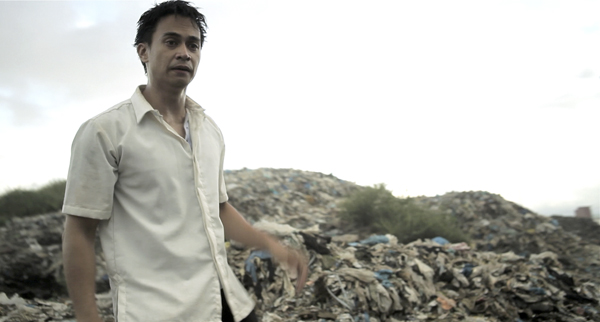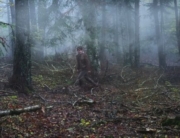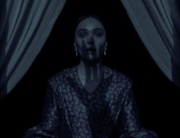
Marlon (Arnold Reyes) in GRACELAND (Sung Rae Cho)
The Tribeca Film Festival offers such a wide array of films from all over the world that some many get passed by amid the list of so-much-to-see-ooh-I-want-to-see-that. With that in mind, here are some notable titles.
Francophrenia (or: Dont Kill Me, I Know Where the Baby Is)
This is, to my knowledge, one of the most unique and cracked films that have played in Tribeca. Its nominally about actor-director-poet-man-about-many-campuses James Franco (co-directing along with Ian Olds) appearing on the long-running soap opera General Hospital. We see him getting made up, then on to some interviews and to greet the myriad of fans waiting by the sidelines for a photo or autograph (scenes so surreal it makes Stardust Memories look quaint by comparison). Then on to shooting the episode, where Franco plays a crazed artist named Franco (!) in one of those over-the-top confrontations that includes the line in the films title.
It might be interesting, up to a point, to see Franco participate in what is one of the most public art shows that is his career. The film is put together as a surface documentary, but it really is about the inner-voice we hear in Francos head, which is often at a whisper and often cursing Franco, asking him why hes even there or what the hell is going on. Perhaps it expresses some of the sentiments of the audience to a fine point. At times the voice-over gets existential (Im all alone in this machine, but I can figure it out), and then the film just turns weird and weirder, becoming more of an acid-noir-abstract-expressionist-WTF by way of Terence Maliks meditations and Godards lets-mess-with-the-audience aesthetic. Im not even sure I liked it exactly, but I dare say its a must-see for filmgoers looking for a highly entertaining and deranged cinema experiment. As for fans of General Hospital hmm.
Graceland
Kidnapping plots arent anything new in movies, but what director Ron Morales does with his pulpy and political crime story, set in the Philippines, is to raise the stakes for the guy on the lower rung of the class system. Marlon (Arnold Reyes, fantastic in what could be a character actor/star making role) is a driver for a crooked congressman. Hes just trying to provide for his daughter while his wife is fatally sick. But his boss, caught in a sex scandal involving an under-age girl, blames Marlon for the resulting media furor and fires him, but on Marlons last day, kidnappers force themselves into his car, a killing occurs, and the perps take away the wrong hostage.
Its through this that, like Kurosawas High and Low, director Morales emphasizes the ills of society as much, if not more, than he does the plots crime elements. What makes Graceland effective and suspenseful is not knowing how this situation will play out. The kidnappers have little to absolutely no humanity (until the third act, where some twists occur), but our allegiance is tested as details are discovered, and not just about the cops, who suspect Marlon is behind the kidnapping, or the sleazy congressman, whose devilishness is horrifying, but about the protagonist as well. Shot in not-too-shaky hand-held and told with an eye for realism and the grime of Manila, the film scores some major points.
Supporting Characters
The wonder with Supporting Characters isnt that its about two film editors (played by Alex Karpovsky and Tarik Lowe), or that its a romantic comedy about their ups and downs with their girlfriends, but that it melds the two plot strands so well. The men are editing a new comedy helmed by a manic-depressive (Kevin Corrigan, funny and sad in every frame), and while dealing with the push-and-pull of the process, their love lives slowly fall apart. Neither storyline is particularly strong on its own exactly (albeit I cant think of the last time I saw a behind-the-scenes take on a fictional movie that focused on the editors), but each supports the other.
Even when a performance isnt always uniformly strong, the lead actors pull it through. Lowe especially comes out as a real breakthrough actor here, with spot-on comic timing, a smart attitude delivering one-liners, and some heart where its needed. The loose comic situations work more often than not, marred only by a generic guitar score and a little lackluster technical issues (i.e. sound).
Jackpot
Jackpot is unabashedly a dark comedy first, a thriller second, shot with the vigor and energy that Danny Boyle had in his early work. Take a dead body, for example. At one point, two characters need to cut up said body to transport out of an apartment. So an axe is used. But where to start? At the stomach, which is full of fat, or just chop off the head? The payoff involves copious blood spurting everywhere. It amusingly works since weve been waiting for the gore.
I neglect to mention the plot, based on a novel by Jo Nesbo. It is surprisingly not that complicated, even with its non-linear narrative. Oscar Svendsen (Kyrre Hellum) is discovered by the police with a rifle in his hands and under the body of a dead rotund woman following a robbery/shoot-out at a strip club. Hes immediately interrogated as the number one suspect. I almost wish the movie didnt have that sort of back-and-forth timeline as Oscar explains his action, but the flashback scenes, showing how a group of lowlifes went in on a lucrative soccer bet together and how their greed spiraled out of control, are consistently and sinisterly entertaining.
Eddie: The Sleepwalking Cannibal
By the title alone you should know that this will be a horror movie and a comedy. How much one trumps the other will depend on how seriously one takes the premise, which I didnt (perhaps for the better). Lars (Thure Lindhardt), a disaffected painter from Denmark, comes to a small Canadian village where the local art school has funding trouble, and the painter is pressured to come up with new work, which he hasnt produced in years. Hes also tasked to take care of Eddie, a mentally challenged man who paints like a four year old (or rather those simplistic drawings one sees on a fridge), and he reluctantly agrees. Lars then finds something peculiar about Eddiehe has a penchant for sleepwalking in the middle of the night and eating small animals. Moreover, Lars own dark side comes through when he sees the carnage: he can suddenly, ravenously, paint and paint well. He unleashes Eddie on unsuspecting townies, and then, overwhelmed by the violence, returns to paint his masterpieces. But will the rest of the town and his possible love interest at the school catch on?
This is silly, over-the-top gory stuff that is kind of like a classy version of what one might expect from Troma. Dylan Smith, playing Eddie, gives his character a lot of charm and energy, making him the most likable character. Biggest fault for me: for a film that is all about the artistic process, we always see Lars and others making art but never actually see what is being painted or what the final result is. Perhaps director Boris Rodriguez finds some perverse irony in it, but I just found it frustrating having not an inkling of what genius came out of Lars.
The Fourth Dimension
If you asked me what a fourth dimension is, I would have trouble telling you. (I might be able to compare it to the video game Portal or a particular line from Back to the Future, but thats about it). This trilogy of shorts, from Harmony Korine, Alexey Fedorchenko, and Jan Kwiecinski, attempts to give some kind of scientific-metaphysical-I-dont-know-what explanation that is bizarrely engaging, hilarious, off-putting, and mesmerizing in equal measure. Most notable here is Harmony Korines segment, The Lotus Community Workshop, which stars Val Kilmer in a Whoa, where did THAT come from? kind of performance. Channeling Tom Cruise in Magnolia, he plays a motivational speaker giving his off-the-wall speech to a group of blue-collar losers in a roller rink. His wild, rambling monologue is then intercut with him and his girlfriend wandering around town, playing video games, and drifting through a video store. Im not a huge fan of Korines work in general, yet here he finds a tone and speed with his editing that are far more focused than anything else hes done.
The other two segments, Chronoeye and Fawns, are hit and/or miss. The first, set in Russia, deals with a scientist who has figured out time travel but cant seem to get past a certain block in his technology while a girl next door dances and plays music. Its a low-key, subtle affair that, like the first segment by Korine, gets a lot of mileage from the performance of its lead (Igor Sergeev) as the beleaguered scientist. The last segment Im still not sure about, which is set in Poland and concerns a group of four kids who traipse about a town that has been evacuated in lieu of an impending flood. They go from house to house just out of aimless curiosity and eventually come upon something startling. This last piece may technically be the best as far as some solid camerawork and a great sense of foreboding, but it feels like it goes on too long until something happens, and when it does, its not interesting since theres no investment with these four not-so-bright kids. Yet for the faults of the anthology overall, the Korine segment, and a few other good touches, makes this a must-see for the festival-goer looking for something culty.
















Leave A Comment